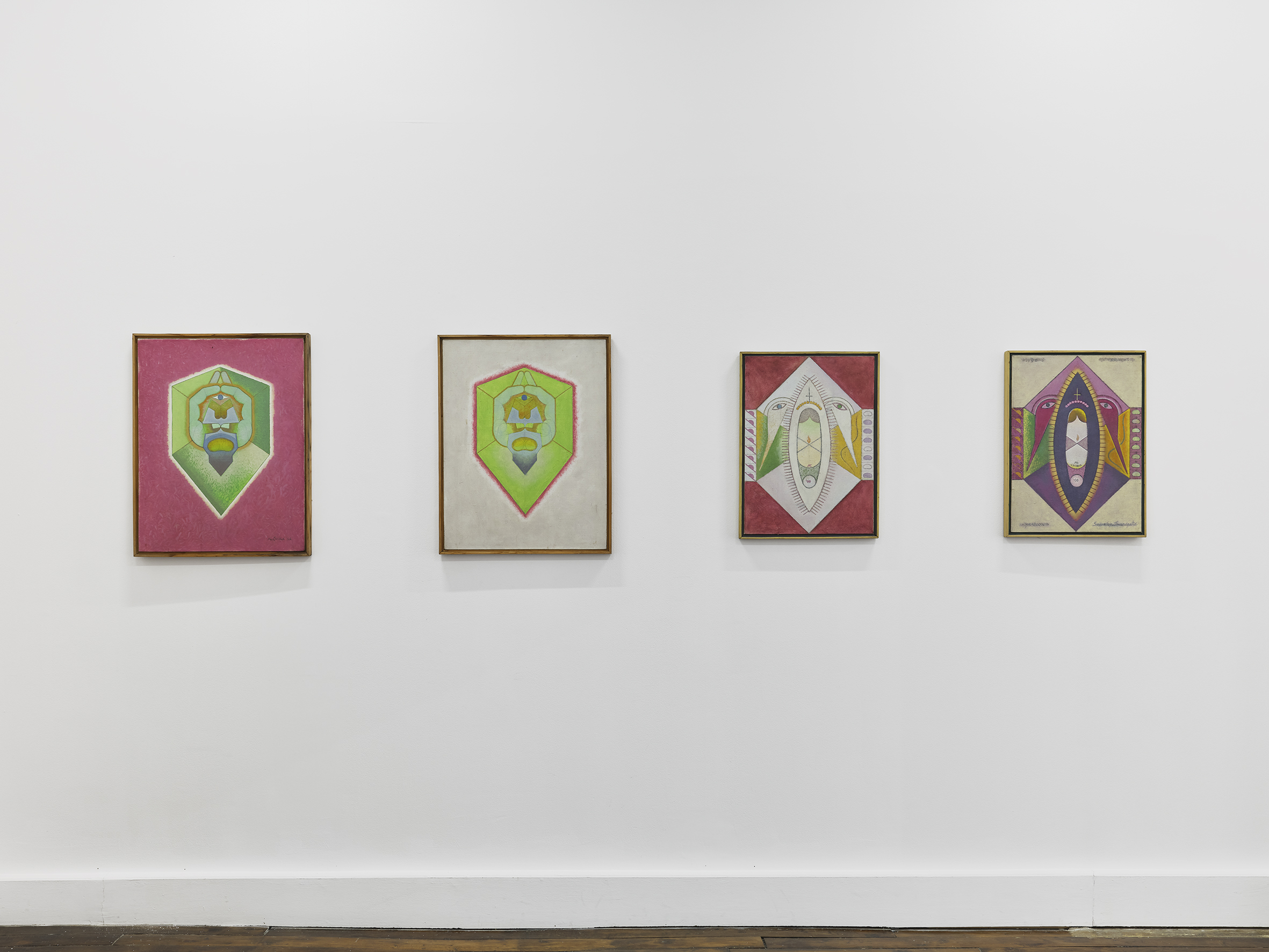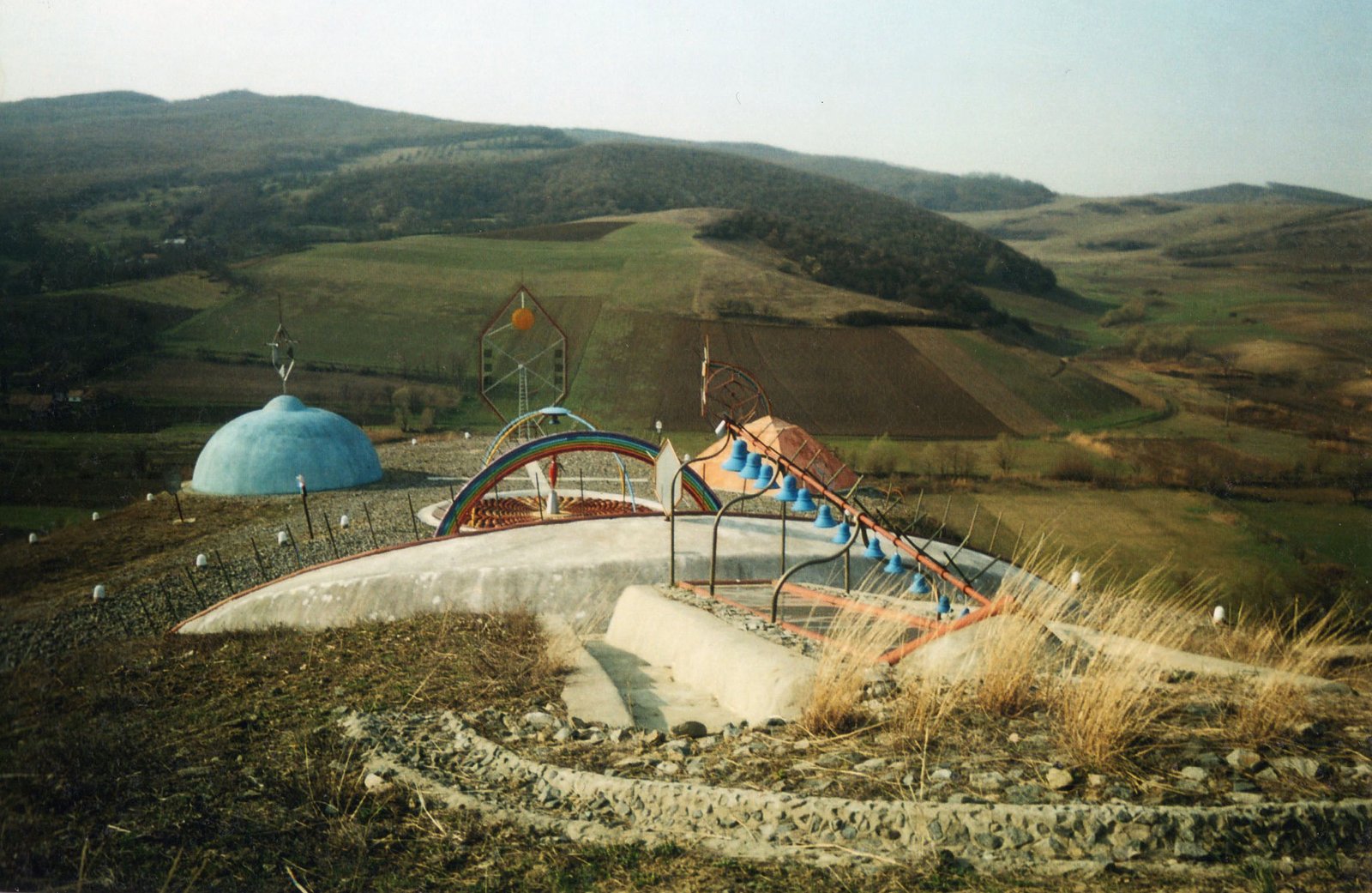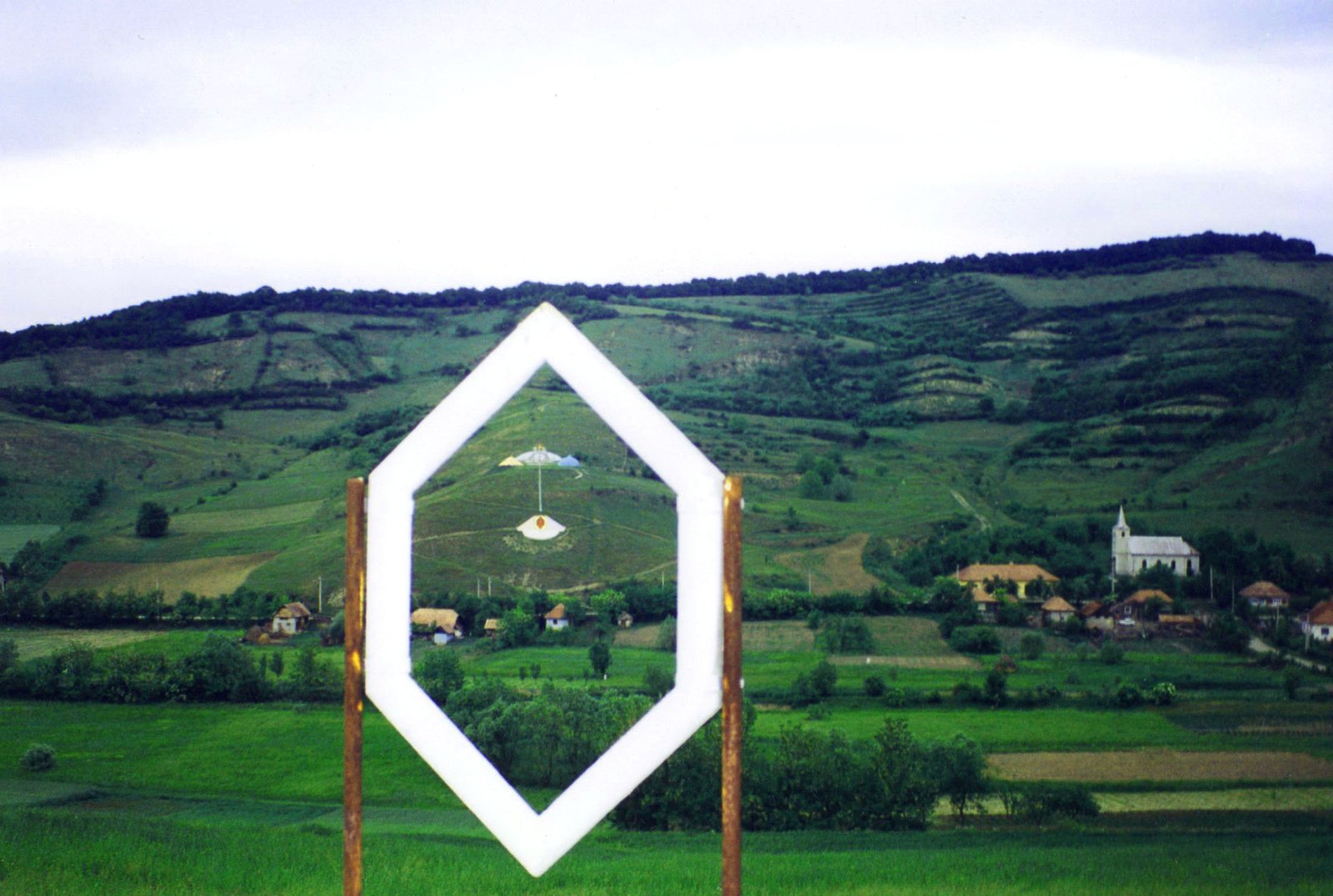Alexandru Chira and the inhabitable artistic edifice
Alexandru Chira used drawing to build an articulated architecture for signification, intended for spiritual habitation
In his philosophic testament, Romanian writer and philosopher Lucian Blaga describes a mythological place whose vistas and perspectives “deepened and rose” with each step, opening onto the mysteries and revelations of a world perceived as a totality. This extraordinary place, the village, is “situated at the center of existence and its geography extended right into mythology and metaphysics.” (1) Painter Alexandru Chira’s childhood spent in Tăușeni, near Cluj-Napoca, provided an open door to the metaphysics of its topography. “For him, the village was a cosmogonic, speculative system akin to that depicted in Lucian Blaga’s philosophy writings,” (2) suggests art theorist and curator Călin Dan. Having studied painting in Cluj-Napoca and Bucharest, Chira later became a professor at the National University of Arts in the Romanian capital, where he stayed until his death, in 2011. Despite having lived an intellectual life afar from the village he grew up in, the formative years, the “mysterious aspects, horizons and secret structures of the village” discovered in childhood modelled his “soul substance”, (3) as Blaga would put it, as well as his artistic identity.
From this imaginative time of heightened sensibility, Alexandru Chira drew significant objects that inhabited and structured it, to create a repertoire of image-signs. Many of these elements were the agricultural and domestic implements used in the practical life of the village: the weaving shuttle, the oil lamp, the planting bed, the spinning wheel, the tractor, the thresher, the spark plug, the fuel tank and so on. They referenced the external, familiar world – the perimeter of the courtyard and the village – immersed in layers of memory and tradition. Less explicitly, his icons took record of the history of his family and their community amid brutal social change: the confiscation of agricultural land and machinery, the alienation of peasants through forced industrialization, and an overall dissolution of the rural identity during communism. Seen in this light, the valorisation of evocative elements which used to circumscribe a collective life threatened with disintegration reads as a subtle, but continuous political undercurrent in Chira’s artistic practice. (4)

Alexandru Chira resists being placed in a certain stylistic category; his art, hermetic, bewildering, difficult to pin down. Călin Dan writes of the difficult task that falls on the viewer, from whom Chira demands a “detectives’ tenacity” and “poetic inspiration” (5), but also on the art critic, for whom Dan believes he has placed “a series of hermeneutic snares, ultimately meant to be playful.” (6) Thus, some clues are welcome in accessing an apparently sealed visual-poetic edifice. Emerging at first in dark drawings of immediate, hectic, almost violent character, Chira’s imagery was later distilled in precisely articulated, balanced paintings that rely on the purposeful tension between means of expression and composition: text and image, drawing and colour, the registers of the work. These internal relationships will constitute our routes to interpretation.
Drawing, colour and the aspiration for poetry
Chira’s works began with a drawing. This was the initial, foundational act. (7) But, being a prolific writer and theoretician authoring a philosophic discourse around his art, Chira has stressed in his essays and interviews that, for him, drawing was not merely a way of occupying and defining the surface of the canvas, neither did it have anything to do with resemblance, or the “nostalgic or journalistic return to motif.” (8) Rather, the artist was working with the idea of „drawing as a project”, that built an „articulated architecture for signification intended for spiritual habitation”. (9)

Drawing was complemented by colour. For art historian Ruxandra Demetrescu, the role that their symbiotic relationship played for Chira, a Poussinist in her view, exemplifies the definitions of painting put forth in the French art literature at end of the 17th century, in which drawing was described as the genus of painting, while colour, the specific difference. (10)
A more unsettled relationship is that depicted by Călin Dan: an exhausting circuit of dominance and submission between the male principle of drawing – a “tormented, but solid skeleton” – and the feminine, calm principle of the colour enveloping it. (11) From this dynamic, drawing emerges in Chira’s mature and late works as the “organising principle, an instrument for measuring the clarity of the message.” (12) At the same time, the colour palette becomes more restrained, the image is purged of spontaneous gestural expression and painterliness, so that its status is set to “colour coats as transparent screens”, “a filter or lens for shading or reading an existing state in the drawing”. (13)

Such statements and interpretations, albeit confusing and apparently contradictory, must not mislead the viewer, for Chira reminds us that, in the end, what he was working towards, his ideal project, was a Painting. (14) In one of his recurring dialogs with theoreticians Radu Procopovici and Theodor Redlow, the artist offers one of the most beautiful and memorable ideas on the problem of colour in painting: “Borderline immaterial, colour remains particularly important for me. It helps me fulfil my aspiration to poetry”. (15)
A visual rhetoric
Making-up Chira’s artworks are visual elements and fragments of written words, formulas, diagrams, lists etc. In earlier works, the text is denser, like an inky web interfering with the paintings, paradoxically obscuring its reading. This density seems to draw attention to the canvas itself, a physical support for marks on a surface, and thus to its two-dimensionality. Later, the writing becomes more condensed and gets absorbed into the image. (16)
Without losing its essential, creative role, the written sign is transposed into image-sign, sustaining the work’s power of projection into three-dimensionality.

Partly capitalised, the written text almost always doubles the visual icon. One of the effects of this approach of approximate translation of terms from verbal to figural image has been perceived as the emergence of “two identities [of the same sign] that undermine each other through redundancy.” (17) However, Chira has discussed this strategy as both a setting of meanings and an opening up through polyphony and multiple reverberations caused by replay. (18) He has also stressed the short-circuiting sought through the multilayering of images and words. (19) The ensuing associations of surrealist character – which also shows up in the typology of the images, and some of the artist’s means of expression (20) – recode each element in relation to the other. Their juxtaposition creates what Juri Lotman would term “an exceptionally strong semantic effect”. (21) Thus the image becomes a text in a semiotic sense, in which all the elements form part of a single text conjuring the viewer’s interpretation.
Chira’s repertoire of symbols, increasingly restricted and refined through the strategy of repetition and resuming of icons, of summarising and encapsulation of meaning, reflects the clarifying aim of his artistic project, that will finally emerge, three-dimensional, into the landscape. Through the exploration of the opacity-depth, figure-ground relations, the iconic and symbolic systems of representation, and the nature of beholding, his work becomes a constant investigation into the processes of depiction and the mechanisms of image creation.His preoccupation with meaning and language inspired Chira to devise words and expressions meant to encapsulate the poetic and conceptual nature of his artistic project. In the 1980’s he came up with the expression de-sign [de-semn], playing with the meaning-making character of the sign, whose invocative power he regarded as both poetic and operational. (22) This dual quality – poetic and projecting, metaphoric and functional – is reaffirmed in his recurrent concepts of the tele-poem or the parcel-poem, which can be sent anywhere. The stereo-poem, and the functional poem, the latter defined by Chira as “a certain state of aggregation and flow of ‘words’” (23) enrich his repertoire of poematic vehicles for communication. For instance, the works titled Packege-poems resemble sheets of paper written and drawn on just as one would in a letter, that have been folded like a partly closed envelope – a heptagon – or rather, caught in the moment of it being opened, of accessing its meaning. (24) The later stereo- and tele- poems take on variations of the recurring geometric shape of the heptagon, which represents the cell of life and “establishes the geometric locus of ideal expression.” (25)
Drawing in space: The monumental ensemble from Tăușeni
In 1994, the Soros Centre for Contemporary Art in Bucharest organised the exhibition 01010101, based on a call for projects. Several artists were commissioned to intervene in various communities and unconventional spaces. It was the starting point of the monumental ensemble from Tăușeni. Designed as the beginning of a larger project, From Hill to Hill to Vienna, [Din deal în deal până la Viena] the land-art intervention was never completed and remains “partly rapt in mystery and only partly rediscovered.” (26)
In a short interview on participatory Romanian art, curator and critic Irina Cios describes how Chira managed to convince the community, the local authorities and his relatives to contribute in creating a monumental artwork in the small village, in close proximity to his family house, by making a road for access, providing materials for its construction, donating the land on which it was to be built. (27) She depicts scenes in which the artist is explaining his conceptual artistic thinking to the villagers in such a fascinating way that the community would subsequently take up the project as their own, caring for it, and generating new mythologies that contributed to its identity. (28) Irina Cios remembers the joy and surprise of visiting the ensemble 5 years after having been inaugurated, when an old lady, a grandmother from the village, gave her a proper guided tour, explaining the meaning of each element forming Chira’s abstract installation. (29) A recent visit paints a more pessimistic scenario, likening it to “a pilgrimage to the ruins” (30) of another age, for the project has been partly abandoned, slowly decaying, mirroring the realities of the rural world.

Titled De-signs to the Sky for Rain and Rainbow [De-semne spre cer pentru ploaie și curcubeu], the ensemble is a “thought drawn in plain sight.” (31) It transposes in sculptural components some of the recurrent elements of Chira’s visual universe depicted until then on the support of paper or canvas. The background and destination of the work is the blue sky. Its basis, the hill that had been a launch pad for his childhood experiments as an inventor. As an artist, he reconfigures the landscape as a plinth for sculpture, and the travel, as a spiritual departure: “From this hill, I dreamed all my childhood of flying off to the moon – a failure guaranteed by my attempt. Thus, later I decided that art makes it possible to fly off spiritually and vanquish technical pragmatism and the laws of inertia and gravity defining it, through poetic utopia.” (32)
In accessing Chira’s utopia, the visitor must follow a ritualic path with several conceptual registers. From The Shepherd’s House, the starting point, one takes the 66 steps of the Sower’s Stairway, “the spine of the ensemble,” (33) to the symmetrically placed Revolving Icon for Rain and Rainbow – an invocation device whose function was accomplished on the day of the inauguration – and House of the Firebird or the House of Rain, situated at the centre of the plateau, where the vertical axis is aligned with the axis mundi. (34) The spiritual itinerary continues from one symbolic element to another, opening up through the vertical axis and radial plane, reaching the plateau of the de-signs in the upper part of the hill, “all the way to ‘the exit from the project’ – towards the sky.” (35)
On the neighbouring hill, Chira installed De-Sign for Sighting. Seen through this shape, the entire work is framed within a hexagon. The sighting from afar of its geometry coincides with viewing the conceptual backbone of his entire “artistic edifice.” (36) Like his House of the Geometrician (of the one who is always designing), the architecture of Chira’s ideal project is characterised by “a simultaneous multi-inhabitance: everyone can enter there, in order to conceive or to read his own projects or even to redesign himself.” (37) It is an artistic edifice projected for the shared space of the artist and the beholder, its open character actualized on the pathway following the coloured drawing on the hill.

[1] Lucian Blaga, “Praise of the Romanian village” [Elogiu satului românesc], Revista Limba Română, no. 2, year XXVII, 2017, 147-48.
[2] Călin Dan, “The Obsession of Synchronicity: on the Challenge to Build the History of Recent Romanian Art”, in Alexandru Chira, eds, Călin Dan, Mădălina Ionescu, Editura M.N.A.C., Bucharest, 2022, 11.
[3] Blaga, “Praise of the Romanian village”, 147.
[4] Mădălina Ionescu, „Alexandru Chira”, in Alexandru Chira, 78.
[5] Dan, “Another Kind of Conceptualism”, in Alexandru Chira, 18-19.
[6] Dan, “The Obsession of Synchronicity”, 8.
Dan, “Another Kind of Conceptualism”, 18-19.
[7] Theodor Redlow, “Proiectul Ideal” [The Ideal Project], Alexandru Chira in conversation with Theodor Redlow, Revista Arta, 4/ 1982, 12.
[8] Alexandru Chira, “Proiectul Ideal”, 12.
[9] Chira, “Proiectul Ideal,” 14.
[10] Ruxandra Demetrescu, book launch of Alexandru Chira monograph, eds., Călin Dan, Mădălina Ionescu, M.N.A.C. Publishing House, Bucharest, 2022. Online discussion moderated by Călin Dan, with Ruxandra Demetrescu, Mădălina Ionescu and Diana Marincu, last access on March 7th 2024, https://m.facebook.com/mnacbucharest/videos/monografia-alexandru-chira/708812047269529/?locale=hi_IN .
[11] Dan, “Another Kind of Conceptualism”, 22.
[12] Dan, “Another Kind of Conceptualism”, 23.
[13] Chira, “Studii pentru o expoziție” [Studies for an exhibition], conversation with Radu Procopovici and Theodor Redlow, published in Alexandru Chira, Cuvinte pentru ochi [Words for the Eyes]: essays, dialogues, articles etc., Charmides Publishing House, 2007, 241.
[14] Chira, “Proiectul Ideal”, 14, author’s emphasis.
[15] Chira, “Studii pentru o expoziție”, 241.
[16] Chira, “Studii pentru o expoziție”, 237-38.
[17] Dan, “Another Kind of Conceptualism”, 19.
[18] Chira, “Proiectul Ideal”, 12.
[19] Chira, “Proiectul Ideal”, 12.
[20] Dan, “The Obsession of Synchronicity”, 11.
[21] Jurij Lotman, Universe of the Mind. A Semiotic Theory of Culture, Tauris & Co, London-New York, 1990, 41.
[22] Ionescu, „Alexandru Chira”, in Alexandru Chira, 79. “Semn” is the word for “sign” or “mark” in Romanian, while “a desemna,” means to name or designate, and is only a letter away from “to draw” [a desena].
[23] Chira, “Proiectul Ideal”, p. 14.
[24] Chira, “Studii pentru o expoziție”, 237-38.
[25] Chira, “Studii pentru o expoziție”, 242.
[26] Diana Marincu, “The Invisible is Real. Alexandru Chira and the Endless Work”, in Alexandru Chira, 48.
[27] Irina Cios, “Arta participativă în România,” ACCESS ART interview series by Asociația Culturală Contrasens, published on September 15th, 2020, https://www.youtube.com/watch?v=Lqb7KbztO-U&ab_channel=Asocia%C8%9BiaCultural%C4%83Contrasens.
[28] Cios, “Arta participativă în România”.
[29] Cios, “Arta participativă în România”.
[30] Dan, “The Obsession of Sincronicity”, 12.
[31] Chira, “Discursul de pe Deal (II). Discurs de inițiere,” speech held on September 25th, 1995, in Chira, Cuvinte pentru ochi, 175.
[32] Chira, “Discursul de pe Deal (VII).” [The speech on the hill] speech held on September 1st, 2000, in Chira, Cuvinte pentru ochi, 184.
[33] Chira’s description of the ensemble, apud. Ionescu, „Alexandru Chira”, 80.
[34] Chira’s description of the ensemble, apud. Ionescu, „Alexandru Chira”, 81.
[35] Chira’s description of the ensemble, apud. Ionescu, „Alexandru Chira”, 81.
[36] Chira, “Proiectul ideal”, 12.
[37] Chira, “Proiectul Ideal”, 14.
April 8, 2024
